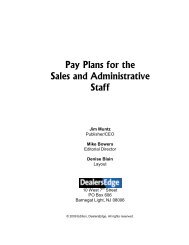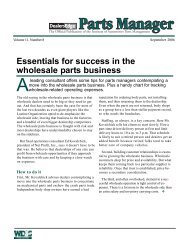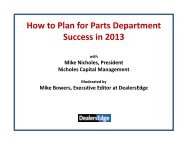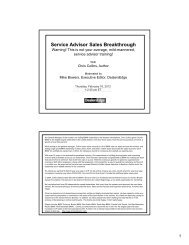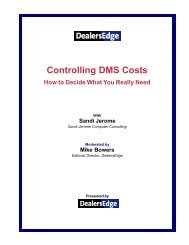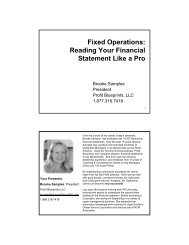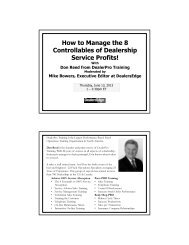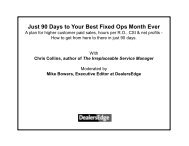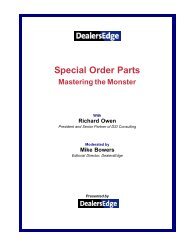How To Avoid Physical Parts Inventory Nightmares - DealersEdge
How To Avoid Physical Parts Inventory Nightmares - DealersEdge
How To Avoid Physical Parts Inventory Nightmares - DealersEdge
You also want an ePaper? Increase the reach of your titles
YUMPU automatically turns print PDFs into web optimized ePapers that Google loves.
14. Purchase Efficiency. [Annualized] <strong>Parts</strong> purchased from outside jobbers and suppliers forstock and on a regular basis. These parts also use sales history as do the parts purchasedfrom the manufacturer on regular, daily or weekly, or ‘RIM’ stock orders. This is often not apopular category with the manufacturer, but it is, nonetheless, an efficient purchase made bythe parts manager which, in return for increased discounts or availability, afford the user instantavailability (the technicians) and thus increase the efficiency in the service department in thedealership. This category is one of three that will be used, in connection with a purchaseefficiency guideline, in the parts department.15. Purchase Efficiency: [annualized] foreign parts purchased by the parts department andprocessed through the accounting functions that are for parts ‘foreign’ to those lines of productcarried by the franchised dealership. These parts, although not purchased on a stock order inthe same fashion as lines #12 and #13, are usually purchased only ‘as needed,’ which could bemisconstrued as an emergency purchase. For posting purposes, they are ‘emergency receiptsor purchases’. The purchase of this category of parts increases the cost-of-sales and affects thegross margin and gross sales in the parts department. In this category, the parts manager didnot have an option of stock order or not and purchased what was necessary, when it wasnecessary, to fill the need of the mechanical shop or body shop. Because these parts areprocessed (in a sales function) as all the others and because the parts manager had nopurchase option, they are deemed to have been purchased “as efficiently as possible” and aretherefore included in the analysis.<strong>To</strong> omit these purchases, which could be very large in the case of the dealership having a bodyshop, would be to dilute the end numbers severely and improperly reflect poor purchasingefficiency when just the opposite is the case. This category is one of the three that will be used,in connection with a purchase efficiency guideline, in the parts department.16. <strong>To</strong>tal Efficient Purchases or Purchases for Stock (Dollar totals from lines 13-15)designate the total dollar amount that the part department purchased in such a way as to bedeemed efficient purchases which, in turn, increased the efficiency of other departments - suchas the mechanical and body shops. No guide is given here for this number; it is used in thecalculation of <strong>To</strong>tal Purchase Efficiency on line #18.17. Purchasing Performance (in the past used to be called stock order performance)⎯adesignation abandoned in the early 1990’s with the advent of daily stock orders) is thepercentage of cost-of-sales (line #8) that were purchased in a manner that gave the highestgross profit margin and offered the customer instant, or near instant, availability.Formula: <strong>To</strong>tal efficient purchases on line #16 divided by the annualized cost-of-sales on line#8.Guidelines vary based on whether the parts department is on a daily or weekly stock or ‘RIM’order.[A PRIME NUMBER FOR EVALUATION]- “RIM’ replenishment order up to 94%- Daily stock order: 85-90%- Weekly stock order: 80-88%In the case of manufacturers using ASR or RIM (automatic stock replenishment or Retail<strong>Inventory</strong> Management) which was pioneered by Saturn, this number will be significantly higherthan those departments that have to ‘place’ a daily or weekly stock orders.5




